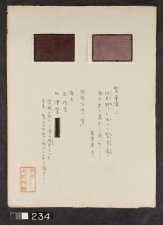Difference between revisions of "Shikon (Gromwell root) - left (234 L)"
Jump to navigation
Jump to search
(username removed) |
m (MDerrick moved page Shikon - left (234 L) to Shikon (Gromwell root) - left (234 L) without leaving a redirect) |
||
| (One intermediate revision by the same user not shown) | |||
| Line 15: | Line 15: | ||
|- | |- | ||
! scope="row"|Fiber type | ! scope="row"|Fiber type | ||
| − | | silk | + | | [[silk]] |
|- | |- | ||
! scope="row"|Color | ! scope="row"|Color | ||
| Line 24: | Line 24: | ||
|- | |- | ||
! scope="row"|Dye (English common name) | ! scope="row"|Dye (English common name) | ||
| − | | Gromwell root | + | | [[Gromwell root]] |
|- | |- | ||
! scope="row"|Dyestuff (botanical name) | ! scope="row"|Dyestuff (botanical name) | ||
Latest revision as of 18:26, 23 June 2020
| Museum number | 234 |
|---|---|
| Uemura number / title | ; "Haze-some 25" |
| Folder location | 4th shelf |
| Sample location | left (234 L) |
| Fiber type | Silk |
| Color | purple |
| Dyestuff (Japanese common name) | 紫根 : Shikon |
| Dye (English common name) | Gromwell root |
| Dyestuff (botanical name) | Lithospermum erythrorhizon Siebold et Zucc. (L. officinale L. subsp. erythrorhizon (Siebold et Zucc.) Hand.-Mazz.) |
| Plant part | root / dried (?) |
| Dyestuff extraction | boiled in water, and dyed in warm bath |
| Auxiliary agent in dye bath | - |
| Mordant | ash water |
| Other auxiliary agent | - |
| Uemura's notes | This purple should be the one recorded in the Buyakuryo (), 8th century AD, Japan. The right sample is the lighter tone (Asamurasaki - )of the left one (Kokimurasaki - ). Since the ancient time, the color called Murasaki () and Hon-murasaki () should be dyed in this manner. The plant was also read in a Japanese classic poem in the Manysh (), volume 3, from the 7th -8th century AD: |
| Uemura's date | Kyoto |
